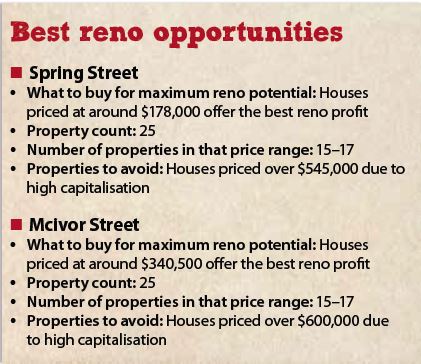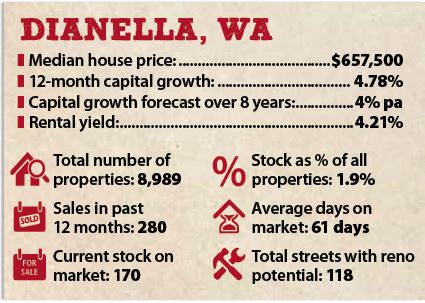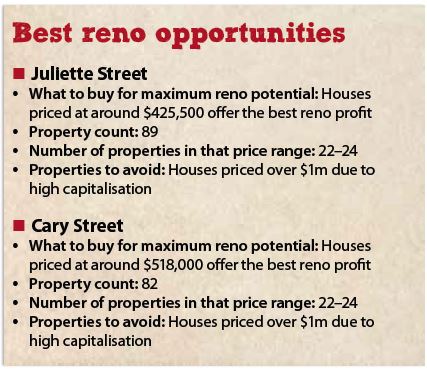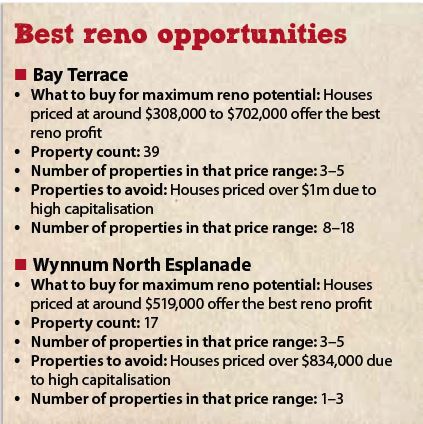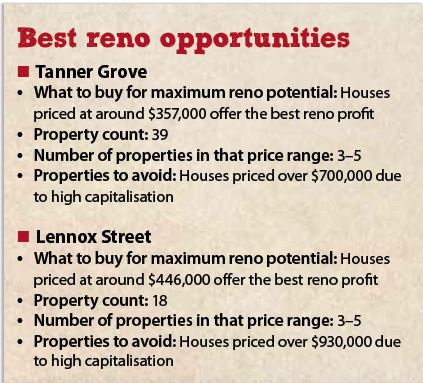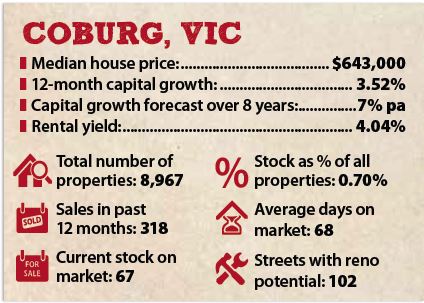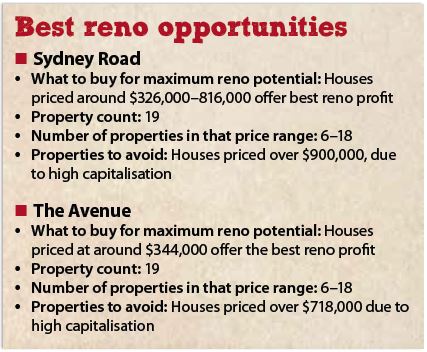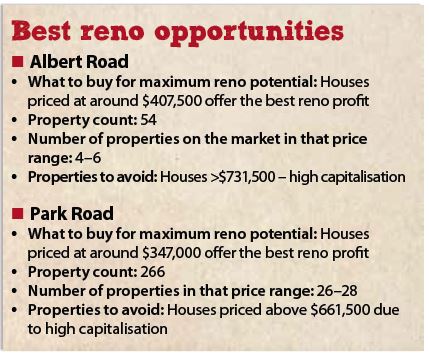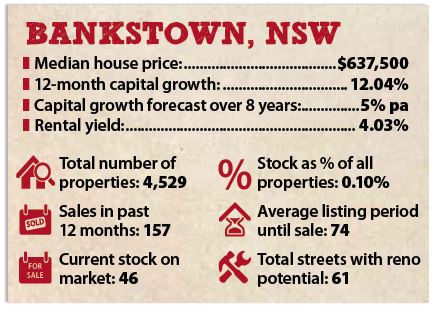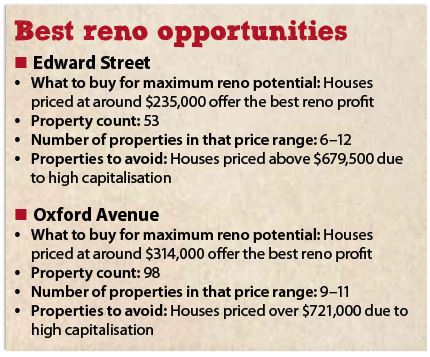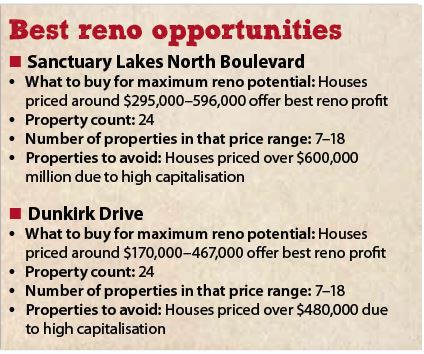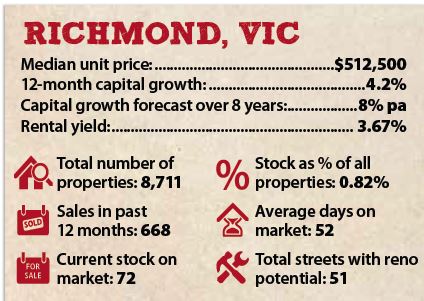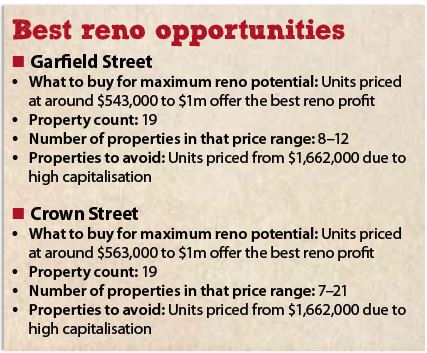What is a good area to renovate properties in?It’s not an easy question to answer. A lot depends on your budget, willingness to travel and whether you’re planning to do the renovation yourself or with professionals. Yet once you take those variables out of the equation, there are a lot of things good renovation spots have in common.
The first is that they, quite simply, need to offer the promise of a profit. There’s no point renovating a property in an area where there is little opportunity to add value. If there is only a small value difference between renovated and unrenovated properties in an area, it will be a poor choice of location for picking up a property to renovate.
That means that, at the very least, a good reno suburb needs to have a large price variation among properties that are sold on the market. An ideal scenario would be where there is a diverse range of prices for properties that are of similar size and age.
Another sign of an excellent location to search for a good renovation opportunity is if the area is an older suburb that’s close to the CBD of a capital city or major regional centre. This usually means the suburb has a desirable location, but some of the properties in the neighbourhood might be in need of an upgrade.
The last critical requirement for an area to fit the grade of a great renovation suburb is that it needs to be changing. Renovated properties tend to be popular when the local resident base is getting wealthier and the suburb is being viewed as a more desirable place to live. This ongoing gentrification process usually drives a big appetite for renovated properties, which helps aurenovators make a profit – either on sale or by increasing the monthly rent they receive.
With this in mind, Your Investment Property, with the help of OnTheHouse.com.au and Residex, has put together a rundown of Australia’s best suburbs for investors who want to find a property to renovate. These suburbs not only feature plenty of older properties in need of restoration, but tend to be close to CBDs, are gentrifying and continue to see massive price differences among properties of a similar size and type.
How to use this report - TERMS USED
- What to buy for maximum reno potential - Each suburb featured lists the ideal property that renovators should be considering if they want to make the most profit in that market. There is a recommended range for the purchase price and type of property, for example house, townhouse or unit.
- Streets with renovation potential - These are streets where there is a big price differential among properties of a similar size and type. Suburbs with more streets with renovation potential make better markets for finding a good property to renovate because there is a better chance of finding a renovator’s gem.
- Average days on market -Investors planning on doing a quick-flip renovation, or any renovation where they are not planning on holding the property for the long term, will need to be purchasing in in a market where sales occur quickly. The average number of days on market indicates the period of time it normally takes an average property to sell once listed.
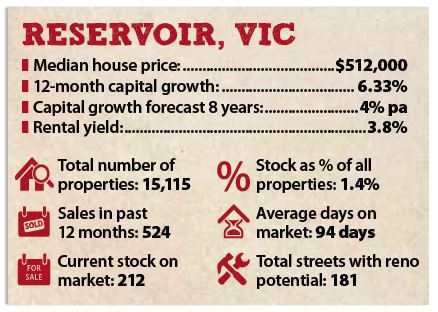
With property prices forecast to be flat within Melbourne for the next few years, Reservoir (12km north of the CBD) provides perhaps one of the best locations in the country for securing a property that is suitable for renovation.
The primary reason is that the area combines an appealing location with an assortment of properties that include dated houses but also newer units and townhouses. In fact, local agent Michael Love of Love Real Estate says it is the newer-build properties that get the most demand, yet “older homes with good-sized backyards” dominate the area.
It all adds up to a strong market for refurbished homes, and Residex numbers confirm there is a large price difference between properties that sell at the bottom of the market and those that sell at the top. In 2013, Reservoir house sales hit a high of $1.1m, while the lowest recorded sale was just $125,000 – such a gap suggests there is plenty of potential for renovators who purchase near the bottom of the market to add value.
The older-style properties that typically lend themselves well to a renovation include brick and weatherboard homes, and most have roughly three bedrooms. Once renovated, the likely tenants or buyers these houses usually appeal to are young families in search of affordable accommodation close to the CBD.
Don’t be fooled by Dianella’s $657,500 median house price. The suburb offers easily one of Perth’s best locations for picking up a property that has plenty of potential for adding value.
Apart from being in a desirable location, famed for its abundant parkland and proximity to the CBD – which is 9km south – Dianella is one of Perth’s most diverse neighbourhoods for property prices. Roughly a third of all houses are between $600,000 and $700,000 – close to the median price – but there are just as many houses within the range of $400,000 to $600,000. Many of these price differences can be found on the same streets.
“Most buyers are looking for a family home, and the average house in Dianella is a three-bedroom, one-bathroom home with a good-sized backyard,” says local agent Licia Santoriello of Property Selection Realty. She adds that such families usually have a mix of choices for housing. This includes older-style brick houses and newer builds, although the former is often on significantly larger blocks.
Adding to the suburb’s offering are two large shopping centres within surrounding suburbs and prestigious public and private schools. The suburb’s popularity is reflected in the fact that it recorded the eleventh highest number of Perth house sales in 2013.
Being just 4km southeast of the Brisbane CBD, Coorparoo enjoys evergreen demand from renters and buyers for the sheer fact that it is conveniently located. Getting to and from work by public transport is a breeze from Coorparoo Train Station, while the suburb’s arterial roads connect it with all of the city’s major thoroughfares.
This alone would make the suburb a handy place to consider for picking up a property to renovate, but other Coorparoo characteristics turn a strong offering into a compelling one. Many of the houses are dated weatherboard homes, some in the Queenslander style, but because the area tends to attract a middle-income demographic, where owner-occupiers outnumber renters, most properties have been well looked after.
Owing to the fact that investors can purchase properties with good, solid bones, but that need something of a modern revamp, the area has become a haven for renovators of late, and sales figures show that there is a large gap between houses selling at the bottom of the market and those selling at the top. Roughly one in eight listed properties tends to sell for between $400,000 and $500,000, while just over half sell between $500,000 and $700,000. The remainder of properties are priced between $800,000 and $2m.
As Sydney’s popular Newtown precinct continues to gentrify, it is attracting more and more residents, something developers have cottoned on to fast. There’s been a rapid succession of new apartment builds in the area, but a symptom of this phenomenon is that property sizes are getting smaller. Newtown has also been a favourite among waves of renovators and subdividers, and many of the older homes on offer have long since been upgraded.
All of this has left neighbouring suburb Marrickville in a strong position, from an investment and renovating point of view, because it offers a lot of the same attractions as Newtown but the houses typically remain a lot more dated and some are larger as well.
Marrickville homes include terraced Victorian houses built in the 1800s and Federation-style homes built in the early 20th century. The potential to add value to these houses is evident in the glaring price differences between renovated and unrenovated homes. PriceFinder.com.au figures show that over 2013 there were 28 sales in the range of $450,000 and $700,000, but significantly more sales (55) were between $600,000 and $900,000. There were also 65 sales over the mark of $900,000.
Like many of the suburbs listed here, Yokine is a diverse place. Older-style properties mix with newer builds and there is a large townhouse and apartment component to the market as well. This reflects the area’s multifaceted appeal, combining a location 4km north of the CBD with excellent transport links, a golf club, shopping centre and reserve.
The majority of newer-build properties are within the southern section of the suburb, but as one travels north the properties tend to get older and some of the streets start to take on a mix of old and modern housing. This presents lots of great opportunities to follow the old renovation cliché of finding “ugly houses on nice streets”.
If an investor was lucky enough to purchase at the bottom end of the Yokine house market, they’d likely be paying around $400,000 to $500,000. However, the majority of houses are priced quite close to the median of $738,000, which means that a successful renovation project on a property at the lower end of the market could result in a fairly substantial value increase. The catch is that the property would likely need to appeal to Yokine’s growing taste for modern-style properties.
This would entail open-living areas and well-lit rooms.The most value-adding potential would also be on properties that suit families, considering that the resident base of singles and young couples tend to rent.
Much of the older parts of Wavell Heights – a northeastern suburb of Brisbane sandwiched between Nundah and Chermside – were once considered blue-collar areas, but the fact that this is changing is an indication of the renovation opportunities available.
Including Nundah and Chermside, the area around Wavell Heights is undergoing a transformation as urban-renewal initiatives take effect and a higher-income demographic continues to move in. Part of this is being driven by renovators and developers who have been encouraged by the local council to help renew the area.
Many of the existing homes were built following WWII and are characterised by weatherboard homes on a variety of different block sizes. There are also some houses built within the last 35 years, which tend to be plastered brick homes.
Affordability is the major driver of the market, and most households are families who have come to the area in search of a home with ample space but one that’s also not too far from the CBD. Approximately 40% of houses sold over 2013 were priced $400,000–500,000, but some 27% were priced between $500,000 and $600,000 and 14% between $600,000 and $700,000. This suggests there’s a lot of potential for renovators who purchase below $500,000 to transform their properties into houses with values on a par with the more expensive ones.
Once covered in mangroves and something of a mudflat, the shoreline of Wynnum never used to be much to marvel at. The development of a marina a few years ago has seen things change, and now the suburb’s location along the shore of Moreton Bay is a major drawcard. It is now one of the most accessible oceanside suburbs in Brisbane.
As a result of this development, Wynnum has been on the receiving end of a major demographic shift. Since 2006, the average household income has risen by just shy of a third and this has put new demand on the supply of quality homes in the area. It’s exactly the kind of environment that successful renovation projects are made of.
Houses include a mix of apartments, larger seaside homes and small, weatherboard houses that used to cater to a more blue-collar demographic. It’s the latter of those three that offer some of the best renovation opportunities. These properties tend to sell in the region of $300,000 and upward, and many are on the same streets as properties that are priced over $450,000.
There aren’t many areas within 8km of the Melbourne CBD that are quiet enough to appeal to families with children, but Northcote is one of them and this continues to be an enduring feature of the neighbourhood.
By sales turnover, Northcote is easily one of the most popular areas in Melbourne, and coupled with the fact that a lot of houses are older Victorian and Federation-style properties, this means the suburb is an ideal location for a quick-flip renovation.
Local real estate agent Gino De lesi of Barry Plant Northcote says that local buyers have a big appetite for quality homes. “Family homes are the biggest in demand by way of three- or four-bedroom houses,” he says. “Depending on the location and land size, these homes can easily reach over $1.3m.
”Of course, investors who purchase properties within the bottom price bracket will probably pay around $500,000 to $600,000. This price is likely to net them a three-bedroom period home, but one that requires a revamp and a good dose of TLC.
“The infrastructure has also changed immensely [in Northcote],” says De lesi. “High Street continues to develop as more and more people see it as a destination with a diverse and interesting range of shops and eateries.”
Richmond, 3km east of Melbourne's CBD, used to be an area dominated by gaudy public housing, but the suburb has been gentrifying since the 1990s and it remains one of the city’s best places to find a property worthy of a renovation.
Many of the best renovation opportunities are some of the suburb’s older houses, but considering their price tag is often in the realm of $800,000, most investors will find themselves priced out of the market. The suburb’s older units and townhouses, while not as abundant in renovation opportunities, also offer good prospects.
A good proportion of unit complexes were built in the 1950s and are typified by three- or four-storey brick buildings with high ceilings. Townhouses tend to be a bit older and date from the early 20th century. Both often come on to the market in an outdated state, leaving investors plenty of room to add value.
Of course, this also depends on an investor’s ability to purchase at the lower end of the market. A significant portion of units (20%) came up for sale in the realm of $300,000 to $400,000 last year, but almost as many units (19%), often of a similar size, sold for between $400,000 and $500,000, while 21% sold for between $500,000 and $600,000.As demand drivers go, the CBD is easily accessible and three of Richmond’s commercial strips are designated ‘Activity Centres’ in Melbourne’s 2030 Metropolitan Strategy.
In an area as old and with as many units as St Kilda, there are bound to be lots of renovation opportunities because of the sheer size of the market, but sales figures confirm the area offers great potential.Over 2013, there was a wide disparity among unit prices. Apartments and townhouses at the bottom end of the market, characterised by a mixture of one- and two-bedroom apartments in bad condition, tended to sell for anywhere between $200,000 and $400,000. The majority of sales (27%) were between $400,000 and $500,000, and were landing their buyers two-bedroom apartments.Thinking those numbers through might be enough to melt a lot of non-mathematicians’ brains, but what the market offers, in a nutshell, is a lot of properties that are selling for significantly less than comparable properties.Those that tend to suit a renovation are two-bedroom properties in need of a revamp. Many of St Kilda’s unit complexes were built in the 1950s and 1960s and, while the ‘skeleton’ of these buildings remains good, occasionally the apartments are in their original condition.As for St Kilda ticking all boxes as an investment destination, renovations aside, consider that the area is arguably Melbourne’s most popular beach hangout and oozes a trendy, bohemian vibe. All sorts come to the area: retirees, singles, students and families.
Snugly positioned in the shadows of the notorious Pentridge prison, Coburg’s location amid prisoner-quarried bluestone lanes is physical representation of the suburb’s changing fortunes.
Closed down in 1997, the prison – which once hosted some of Australia’s most infamous criminals (including Ned Kelly and Chopper Read) – has been redeveloped as housing estates, parklands and a business precinct. The former D Division is now an exclusive function venue.
Meanwhile, Coburg itself, long one of Melbourne’s most multicultural suburbs, is now being slowly gentrified. Its popularity is growing because of its cultural diversity, closeness to the city centre and period architecture, says Verica Jokic from City Hobo, . “For decades, there has been a strong Greek and Italian presence but, in recent years, people from Arabic backgrounds have settled there, as have younger professionals with or without kids.”
There are many Victorian, and some Edwardian, houses in Coburg, but the suburb’s typical property is the Californian bungalow, according to Michael Chan from Hocking Stuart Coburg. “This style of property is also particularly desirable to renovators. We are seeing them extend them out and also add more open-plan spaces into them.”While property prices have started to rise, it is still affordable compared with many other inner-suburban Melbourne locales.
With a city motto of “many cultures, one community”, Auburn prides itself on being one of Australia’s most ethnically diverse communities. According to the 2011 census, 56.9% of the Auburn LGA population was born overseas – and represents 124 countries and over 67 language groups.
The resulting diversity of people, customs, languages, traditions, religions and cuisines makes the suburb a particularly vibrant and interesting place. It also means the suburb is a first place of settlement for many newly arrived refugees and migrants.
Greg Okladnikov from Starr Partners Auburn says the multicultural variety to be found in Auburn is just one of its attractive features. Others are its relative proximity to the Sydney CBD, its ease of public transport access and good amenities.
It is an increasingly popular and in-demand area, Okladnikov says. “While the suburb appeals to a broad demographic, we have noticed there is a bit of a flow-on of the style of buyer from the inner west of Sydney.”
Typical Auburn properties tend to be older, single-frontage houses and older-style 50–60-year-old houses, with some fully renovated houses and newer mansion-style houses in the mix too. It is the older single-frontage and 50–60-year-old houses that seem to be most popular with renovators, although there is potential throughout the suburb.
Generational flow, and the established community spirit that comes with it, characterises Bankstown. While it has suffered from some bad press in the past, long-time residents are passionate about this outer-Sydney suburb.
Known for its multicultural demographic, it is an area that has a lot of new migrants. However, Tony Roumanous from Ray White Bankstown says people who have grown up in the suburb tend to stay put and bring up their own families here.
“We are seeing the second and third generations of families who settled here when they first arrived in Australia,” Roumanous – who fits that bill himself – says. “For that reason, there is a tight-knit community which is very family oriented.”
Located 20km from the Sydney CBD, Bankstown is the administrative centre of the broader LGA. Home to Bankstown Airport as well as TAFE Bankstown and a University of Western Sydney campus, the suburb is well served by all necessary amenities.
Bankstown’s family appeal is enhanced by its spectacular array of parks and sporting reserves. These include the Georges River National Park, the Bankstown Oval, Paul Keating Park and the Bankstown City Gardens.
Fibro and brick veneer houses dominate the suburb and they are available for comparatively affordable prices, Roumanous says. “People are buying these properties for a reasonable price and then spending a bit of money to do them up.”
South Yarra is home to many historic mansions and heritage registered buildings. There are also some notable clusters of beautifully preserved, highly sought-after Victorian terraced housing. Further, several streets feature important examples of art deco housing.
The suburb is currently undergoing transit-oriented urban renewal concentrated in areas like the Horace Petty Estate precinct. There are also some reasonably priced, chic apartment blocks scattered throughout South Yarra. This means there are affordable options available.
A Capital Property Advisory representative says this is a well-known, affluent suburb, which always outperforms the average. Located 4km from Melbourne’s CBD, it is home to some of the city’s most prestigious residential addresses.
She says its fantastic public transport connections and many attractions – including trendy, upmarket Chapel Street and the Jam Factory – mean the leafy location is particularly appealing to couples, singles and students.
The Victorian and Edwardian properties with elegant facades are far and away the most desirable to renovators, says Lachlan Castran from Castran Gilbert. “In the unit market, it is the 1960s and 1970s blocks which are increasingly popular for renovation. This is because of their large floor plans, which tend to be much bigger than what is available in similar types of properties today.”
Less than 20 years ago Point Cook was a sleepy, essentially rural community with a population of just 580.
Fast-forward to the 2011 census and the population was sitting at 32,413. By 2016 this is expected to be around 41,474. This speedy growth rate makes Point Cook one of Australia’s fastest-growing suburbs.
Kay Righetti from Point Cook Real Estate says there can be no dispute that the suburb is in demand, particularly with families. “People tend to be attracted to the affordability and the fact it is pretty close to inner Melbourne. Once people see what the area has to offer, in terms of lifestyle, they fall in love with it.”
Lifestyle properties suited to families are in high demand. Fortunately, a typical Point Cook house is less than 10 years old with multiple bedrooms and bathrooms and a double garage.
Cosmetic renovation work is increasingly popular, Righetti says. “Older houses are on larger blocks of land than newer ones, but they can look dated. People are buying older properties on bigger blocks and renovating so their house is in line with the newer ones and what they offer.”
Once tarnished by commuter traffic problems, Point Cook has a new train station and recently extended bus routes, meaning public access to the city is now significantly improved. This development further enhances the suburb’s potential for renovators.
Famous for its live music scene, Richmond is a study in contrasts. The inner-city suburb boasts one of Melbourne’s most varied demographic profiles, along with an eclectic mix of architectural styles.
Richmond has people from every conceivable ethnic, cultural, religious and social background, says Verica Jokic from City Hobo. “It has used the diversity to build what is one of the most vibrant places to live in Melbourne.”
There are three major shopping areas and a multitude of cafes, restaurants and nightlife options. Thanks to these attractions, Richmond is known as one of the most fun, funky and lively sections of the city.
These entertainment options, plus proximity to Melbourne University and the CBD, make the suburb particularly attractive to a younger demographic. But Richmond also has much to offer families. Bordering the Yarra River, it has some lovely parkland and public open-space areas.
Gentrification of the suburb has been going on for some years. It is now made up of everything from converted-warehouse residences to Victorian era terraced housing.
Single-fronted and double-fronted Victoria cottages are most popular with renovators, says Russell Cambridge from Biggin & Scott Richmond. “I have noticed that 1970s red brick, one-bedroom units are popular with aspiring developers. They add on balconies, and the properties come up lovely.”
Multicultural, lively and bursting with potential, Merrylands has been the victim of some bad press. Its advocates argue that this has been unfair and that the resulting reputation disguises the suburb’s many attractions.
Sitting about 20km west of the Sydney CBD, right next to Parramatta’s CBD, and serviced by excellent public transport, Merrylands’ prime location – and resulting convenience – is one of its big selling points.
Another major attraction is Merrylands’ affordability, especially when compared to neighbouring suburbs like Parramatta and Westmead, says Daniel Starr from Starr Partners Merrylands. “ This feature, combined with its geographical position, means it is very popular with buyers who tend to come from a broad mix of cultures.”
There is a real mix of apartments, duplexes, villas and townhouses in the area. Close to the station there is a higher density of living, with apartments dominating, although the typical property remains a three-bedroom home, Starr says.
“Investors and new buyers are seeking apartments, townhouses and villas, while developers are seeking larger blocks for short- or long-term development. Recently, there has been a push for modern-living duplex development.”
Merrylands’ sub-$380,000 apartments offer good long-term value for investors, Starr adds. “However, scope for renovation is high, with carpet and painting the most effective types of work.”
